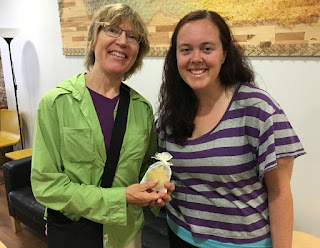For the last day in Santiago I planned on leaving the remaining 3 ex-votos. Two would be left at the Cathedral after the English Mass in the morning. Before the service, I wanted to go through the Puerto del Perdon, or Door of Pardons, on the Praza da Quintana side. This special door is only opened during Holy Years, or when St. James festival day, July 25, falls on a Sunday. However, 2016 was declared the "Year of Mercy," and the doors were opened.
On previous days crowds wound around the plaza waiting to enter the doorway as shown above. I walked over after breakfast when people hadn't arrived yet. Above the iron gate are St. James and disciples Athanasius & Theodore at his side; flanking the doorway are relief sculptures of figures from the Old Testament.

The back of St. James can be seen from inside the iron gate.
The entranceway leads to bronze doors that open up to the ambulatory, or walkway behind the altar. The doors weigh over 1,300 pounds and were installed in 2004 to commemorate the Holy Year. They have bas relief panels that depict important events in the life of St. James.
The Baroque altar includes the 13th c. stone sculpture of St. James seated. One hand holds a pilgrim's staff with gourd and the other hand holds a tablet with the Latin inscription: "This is the body of the Divine, and of the Apostle St. James the patron of Spain." The figure's mantle, or cape, has the red cross of St. James. A pilgrim tradition is to climb up stairs behind the sculpture and embrace St. James to give thanks for the journey completed.

An English Mass is held every day at 10:30 a.m. in the Cathedral's Sancti Spiritus Chapel. Visiting priests deliver services, and volunteers help oversee the chaplaincy program. As I waited for the Mass to start, the volunteer asked me and a walker from New Orleans, Leila, to participate with a reading during the service.
After the service I placed the pancreas and torso in their presentation bags by the chapel's "intention" baskets where messages and prayers can be left.
Next, I took the shell over to the Pilgrim House, founded by Americans Nate & Faith Walters, originally from Chicago. They opened the center in July 2014 as a place for Camino walkers to 'decompress' and process their experiences after the journey. It's run in partnership with the organization Terra Nova, whose mission is to serve & celebrate pilgrims. The Pilgrim House offers wifi, laundry service, backpack storage, and printing/copying. It also hosts gatherings where walkers can meet & share.
Gail, originally from Pennsylvania and now working at the Pilgrim House, took the shell and will add it to others brought by walkers in memory of Denise.
In the afternoon I toured the Cathedral's museum, which encompasses several different levels and birds-eye views of Praza do Obradoiro. Across the plaza is Pazo de Raxoi, the 18th c. neoclassical town hall and seat of the Galician government, or Xunta. It once housed a jail and was named after Archbishop Bartolome Raxoi, who had commissioned its construction.
On the north side of the plaza is Hostal dos Reis Catolicos, the parador where I had the free pilgrim meal on the first full day in Santiago.
Pilgrims, tourists, and locals make up the plaza scene.
In Arco de Palacio, the archway that leads into Obradoiro Plaza, musicians played Celtic inspired music with what looked like traditional Galician instruments. A group in regional costumes joined them. This spot often has musicians playing a variety of music, from bagpipers (reflecting Galicia's heritage) to classical selections. I've heard opera singers perform here too.
Earlier in the day the costumed group had been at San Martin.
In the afternoon I saw them walking near the Cathedral, and later they participated in a fashion show of regional costumes held in Praza da Quintana.

The narrowest street in Santiago is Callejon de Entrerruas -- a man and 2 kids wide.
Dinner was at Casa Manolo, where a 5 star 2 course meal (plus dessert & beverage) is served at menu del peregrino prices. Dad and I ate here last year and enjoyed the festive atmosphere. This time I ordered Padron peppers for my primero course -- grilled just right and sprinkled with sea salt -- delicious.
The restaurant's owner, Manolo, has walked the Camino. He stamped my credential as I paid for the meal.
The last day ended with a stroll around Alameda Park that overlooks the city and Cathedral. The park's origins go back to the 16th c., and its gardens are the setting for many cultural and festival events.

Swans caught the attention of park visitors.
A bronze of Galician writer Ramon Maria del Valle Inclan seems to dare the viewer to sit with him. The sculpture was created by Cesar Lombera and installed in 1999. Valle Inclan was known for his long beard and enjoyed looking at the cathedral from this area of the park.
At the end of my walk I ran into Leila, whom I first met in Obradoiro Plaza and then again at the English Mass. She's a principal for a girls' Catholic high school and walked from Sarria to Santiago before starting the school year. At the park Leila gave me a gift of rosary beads she had bought in Santiago & were blessed by an Irish priest -- the beads are in the shape of shells. It was a thoughtful gesture of Camino spirit!






















































